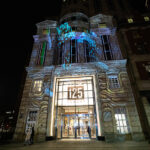On March 8, 2014, The Cleveland Cavaliers honored their former center, Zydrunas “Big Z” Ilgauskas, by officially retired his #11 team number. But the Cleveland Cavaliers QTV crew did it with a lot more visual sizzle than just an announcement over the P.A. and I-Mag on the center video display. They teamed up with Think Media and Quince Imaging to produce a large format projection that not only covered the expanse of the court but was mapped to its various parts, transforming the 2D surface and content with 3D movement and effects.
 Working in tandem with visuals overhead (for those with less-advantageous seating positions near court level), it transfixed attendees with a dazzling pregame and halftime spectacle. And the content was seen by more than those within the Cavs’ 20,562-capacity Quicken Loans Arena (a.k.a. “The Q”). The visuals were picked up by national media outlets including NBC’s Today Show.
Working in tandem with visuals overhead (for those with less-advantageous seating positions near court level), it transfixed attendees with a dazzling pregame and halftime spectacle. And the content was seen by more than those within the Cavs’ 20,562-capacity Quicken Loans Arena (a.k.a. “The Q”). The visuals were picked up by national media outlets including NBC’s Today Show.
 Scott Williams, owner of Quince Imaging, notes that the Ilgauskas tribute in Cleveland wasn’t the first time the company has projected visual content onto a basketball court. “For the past couple of years, we have done similar events like the Cavs pre-game show for the Miami Heat, and DC’s Washington Wizards at the Verizon Center.”
Scott Williams, owner of Quince Imaging, notes that the Ilgauskas tribute in Cleveland wasn’t the first time the company has projected visual content onto a basketball court. “For the past couple of years, we have done similar events like the Cavs pre-game show for the Miami Heat, and DC’s Washington Wizards at the Verizon Center.”
 The March 8 display, however, took things up a notch, fully leveraging the potential of projection mapping to fool the eye with 3D transformations. The project required projected imagery to be precisely mapped to court zones and features, all within a total 3,600-by-1,878-pixel space. The arsenal of gear included 16 HD projectors (12 Barco HD20, four Barco HD18) and four Pandoras Box Media Servers media servers running v5.5 software along with the latest version of Warper.
The March 8 display, however, took things up a notch, fully leveraging the potential of projection mapping to fool the eye with 3D transformations. The project required projected imagery to be precisely mapped to court zones and features, all within a total 3,600-by-1,878-pixel space. The arsenal of gear included 16 HD projectors (12 Barco HD20, four Barco HD18) and four Pandoras Box Media Servers media servers running v5.5 software along with the latest version of Warper.
 Doing the Math
Doing the Math
Leading up to the March 8 show, Quince Imaging worked with the Cavs and Quicken Loans Arena to align the 12 20K HD projectors with the dimensions and painted elements on the court surface. Despite a significant amount of preplanning, more than a little tweaking was done onsite to get everything perfectly aligned, notes Eric Gazzillo, media server programmer from Quince Imaging.
 “Despite our best efforts and countless measurements, the court never seems to be in exactly the same place — it would be slightly off center from our initial measurements,” Gazzillo says. He notes that the arena floor is regularly removed, replaced and shifted around to accommodate varying seating configurations for different sports events, and while the physical court is put down with precision — usually within an inch — “the painted aspects are not always laid down accurately to their respective drawings.” Gazzillo adds, however, that new software reduces those needed tweaks to “a small problem.”
“Despite our best efforts and countless measurements, the court never seems to be in exactly the same place — it would be slightly off center from our initial measurements,” Gazzillo says. He notes that the arena floor is regularly removed, replaced and shifted around to accommodate varying seating configurations for different sports events, and while the physical court is put down with precision — usually within an inch — “the painted aspects are not always laid down accurately to their respective drawings.” Gazzillo adds, however, that new software reduces those needed tweaks to “a small problem.”
 Quince Imaging owner Scott Williams mentions a few additional challenges that needed to be overcome. “None of the equipment could hinder the sightlines of any of the seats, even the nosebleed sections,” he says. “After all, they paid to see a basketball game, not a projector blocking their view.” And the overall light levels had to be right — not just for spectators in the arena finding their way safely to their seats, but for the TV cameras aimed at the floor visuals.
Quince Imaging owner Scott Williams mentions a few additional challenges that needed to be overcome. “None of the equipment could hinder the sightlines of any of the seats, even the nosebleed sections,” he says. “After all, they paid to see a basketball game, not a projector blocking their view.” And the overall light levels had to be right — not just for spectators in the arena finding their way safely to their seats, but for the TV cameras aimed at the floor visuals.
 Despite the need for onsite tweaking, the advanced prep work and calculations usually enable the techs to be rehearsing the videos within six hours of the trucks hitting the dock. For the Cavs event, the ability to load in quickly proved particularly advantageous when pyro flame effect testing forced a delay before crews could get the video gear in place. “We had a luxury of extra rehearsal time due to the quick load in, and the Cavs providing extra time in order for the projections to perform flawlessly. They did!”
Despite the need for onsite tweaking, the advanced prep work and calculations usually enable the techs to be rehearsing the videos within six hours of the trucks hitting the dock. For the Cavs event, the ability to load in quickly proved particularly advantageous when pyro flame effect testing forced a delay before crews could get the video gear in place. “We had a luxury of extra rehearsal time due to the quick load in, and the Cavs providing extra time in order for the projections to perform flawlessly. They did!”
 Behind the Scenes Teamwork
Behind the Scenes Teamwork
The content that brought the court to life was a close collaboration between Quince Imaging and the Cavs’ TV crews. While Quince Imaging handled the 3D content, such as the imagery creating the illusion of a “falling court” and other animations running throughout the video, the Cavs TV crew provided most of the historical images, video and audio.
 “Our creative division, which is one of our specialties, took all of the content and brought it together in house to make the two separate videos,” says Williams. “To start off, we reverse-engineered the mapping from the court into a wireframe, based on the calculations of where the projectors would hang, and began putting the 3D mapping together.”
“Our creative division, which is one of our specialties, took all of the content and brought it together in house to make the two separate videos,” says Williams. “To start off, we reverse-engineered the mapping from the court into a wireframe, based on the calculations of where the projectors would hang, and began putting the 3D mapping together.”
Quince Imaging also handled all of the rendering and processing of the video mapping in house. “In total, we had four servers processing and running the projection.” While noting that, “with a high profile and important project like this, running multiple servers is a must,” Williams adds “we never ran into any problems.”
Crew
Producer: Cleveland Cavaliers, QTV team
Projection Designer: CJ Davis
Media Server Programming: Eric Gazzillo, Kevin Morris
Chief Engineer: Anthony Magdon
Projection Engineers: Patrick Rellihan, Sean Hovan, Jay Hutchison
Video Content: Think Media, Inc.
Social Media Aggregation: Postano
Gear
4 Pandoras Box media servers
12 Barco HD20 projectors
4 Barco HD18 projectors
2 Lightware DVI routers
12 ThinkLogic fiber transmitters
2 Da-Lite screens (16’x28’)


